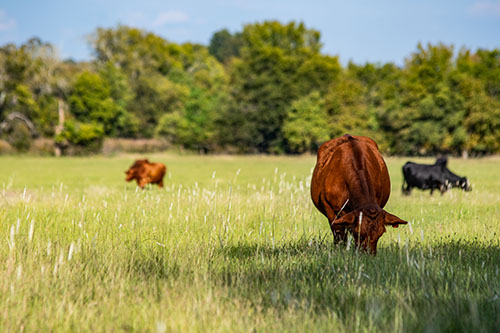Mineral Supplements Designed for Local Forages
Oct 18, 2021

In a perfect world, the forages grown on our farms would provide all the protein, energy, vitamins, and minerals our cattle need to grow, reproduce, and give milk at a desirable rate. Since that’s rarely the case, nutritional supplementation has become common practice for beef producers looking to improve the profitability of their operations. Minerals play a vital role in beef cattle performance and the mineral levels present in our forages seldom meet the requirements of cattle. Though forages are not completely devoid of minerals, key elements such as phosphorus, copper, zinc, and selenium are often present in low amounts and their content in forages can vary with season and geography.
Regional differences in soil type, soil pH, and fertilization programs all influence the concentration and availability of individual minerals, and thus alter the amounts that must be provided in a supplement. Think of the difference between what forages provide and what the animal requires as a gap that must be bridged by the mineral supplement. If all forages had the same mineral composition and all cattle had the same requirements, it would be a simple matter to have a “one size fits all” cattle mineral. This too, is rarely the case.
To further complicate the matter, even if an adequate amount of a given mineral exists in the forage, there may be antagonists present that reduce the availability of those minerals. Sulfur is a common antagonist found in the Southeast at levels that interfere with the uptake of both copper and selenium. Numerous other mineral to mineral interactions also exist that can prevent proper absorption of important minerals. These imbalances and interactions make mineral supplementation a very complex issue. Understanding the unique profile of the minerals present and taking them into account is essential when formulating mineral supplements for a specific geographic region.
Mineral supplements for beef cattle should be formulated based on mineral content of forages in the region in which they are fed. Tennessee Farmers Co-op assisted with the University of Tennessee’s Forage Mineral Survey conducted from 2001 to 2004. Over 1,000 forage samples were collected from across the state and evaluated for mineral content. The results of this study and others have been used by Co-op to formulate mineral products that strategically address the specific mineral deficiencies and excesses present in our market area.
Cattlemen should always be looking to implement nutritional programs that provide the greatest return on their investment. Mineral supplementation is a wise investment that provides cattle with the mineral nutrition that forages cannot. Correcting mineral deficiencies can have a significant impact on animal performance and an operation’s bottom line. Be sure the minerals you provide have been designed to fit the forages your cattle consume. Contact your Co-op Feed Specialist to develop a mineral program that meets your specific needs.
For more content like this, check out the latest issue of the Cooperator.
Regional differences in soil type, soil pH, and fertilization programs all influence the concentration and availability of individual minerals, and thus alter the amounts that must be provided in a supplement. Think of the difference between what forages provide and what the animal requires as a gap that must be bridged by the mineral supplement. If all forages had the same mineral composition and all cattle had the same requirements, it would be a simple matter to have a “one size fits all” cattle mineral. This too, is rarely the case.
To further complicate the matter, even if an adequate amount of a given mineral exists in the forage, there may be antagonists present that reduce the availability of those minerals. Sulfur is a common antagonist found in the Southeast at levels that interfere with the uptake of both copper and selenium. Numerous other mineral to mineral interactions also exist that can prevent proper absorption of important minerals. These imbalances and interactions make mineral supplementation a very complex issue. Understanding the unique profile of the minerals present and taking them into account is essential when formulating mineral supplements for a specific geographic region.
Mineral supplements for beef cattle should be formulated based on mineral content of forages in the region in which they are fed. Tennessee Farmers Co-op assisted with the University of Tennessee’s Forage Mineral Survey conducted from 2001 to 2004. Over 1,000 forage samples were collected from across the state and evaluated for mineral content. The results of this study and others have been used by Co-op to formulate mineral products that strategically address the specific mineral deficiencies and excesses present in our market area.
Cattlemen should always be looking to implement nutritional programs that provide the greatest return on their investment. Mineral supplementation is a wise investment that provides cattle with the mineral nutrition that forages cannot. Correcting mineral deficiencies can have a significant impact on animal performance and an operation’s bottom line. Be sure the minerals you provide have been designed to fit the forages your cattle consume. Contact your Co-op Feed Specialist to develop a mineral program that meets your specific needs.
For more content like this, check out the latest issue of the Cooperator.